A Chair to Hang Your Hat On – Chinese Yoke Back Chairs
PRIMITIVE - Tuesday, February 03, 2015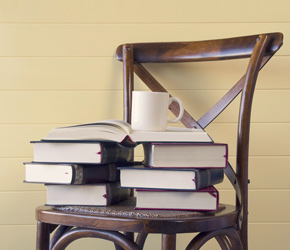 |
|
By Misaki Imagawa
At one point during high school my room was home to nine chairs: a desk chair, a couch, an armchair, an ottoman, two bar stools, one dining chair, one swivel chair, and a bean bag cushion. As you can imagine, there was more sitting room than walking space, and my room wasn’t too big anyway. In looking back, the question arises: why did I have so many chairs? There is no convincing answer other than one: what came into my room usually never made it back out. Yet, I was pleased with the array of seats accumulating in my domain – inevitably finding a use for each. I would hop from one to the other depending on my mood and chairs would hold my bag, clothes, hats, jackets, books etc. All in all, having nine chairs in my room was quite convenient.
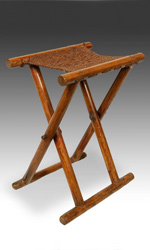 |
|
PRIMITIVE ID# F0309-074 |
Imagine my dismay upon returning to my family home in Japan and discovering there was only one chair in the whole house beside those surrounding the dining table. “Chairs are so uncomfortable,” my grandmother proclaimed. “The floor is much better.” I begged to differ; but like in most Asian countries, sitting on the floor was a common practice in Japan since ancient times. I eventually found beauty in this rustic tradition and was bewildered when I learned that neighboring China had adopted the chair centuries ago. I asked myself, how did that happen?
In ancient China, it was customary for people to kneel, like we did at my grandmother’s house, or sit cross legged on the floor. Their style was simple and minimalistic, focused only on necessities. The rooms were furnished only with mats, armrests, and perhaps a few low tables and decorative screens. In fact, ancient China was called a mat culture. However, around the second century Buddhism made its way into China and brought with it the concept of officials and high religious dignitaries sitting on raised platforms. These elevated platforms were initially seats of honor, and eventually were used for reclining as daybeds. Around this time, the Han emperor Lingdi was said to be fascinated with all things foreign and took particular interest in huchuang, a folding stool used by nomadic groups living in remote northern and western regions. The huchuang, or foreign ‘barbarian’ seat was lightweight and convenient for travel and it wasn’t long before the chair was adopted for use by nobility.
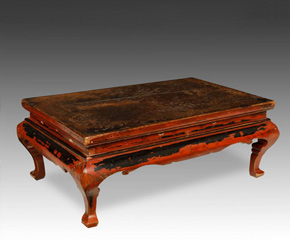 |
|
PRIMITIVE ID# F021001-180 |
At first, chairs were available only to royalty, nobility, high ranking officials and scholars. Sitting on the newly embraced chairs were indicators of one’s high social status. Between the seventh and tenth centuries, chairs and stools became commonplace among the upper class population; and by the 12th century sitting on the floor had become rare in all classes. China was no longer a mat culture, but it wasn’t until the Ming (1368-1644) and Qing dynasties (1644-1912) that Chinese furniture in general, and chairs, specifically, reached a high point in production and design. This might be considered the golden age of Chinese furniture. During this time, furniture design became a true art form, transcending simple utilitarian forms. Individual pieces of furniture became objects of beauty. In many cases, styles remained simple, but craftsmen perfected the art of elegance by incorporating pleasing curves in the wood. In addition, furniture joinery became so accurate nails and glue was not a requirement for the final assembly of pieces.
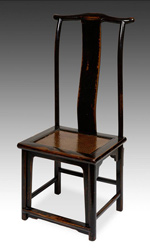 |
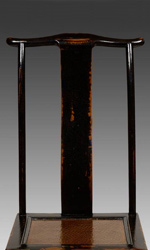 |
|
Perhaps the most famous chair created during the Ming and Qing dynasties is the yoke-back chair, which appeared in both armed and non-armed versions. Though its earliest prototypes can be found depicted in artworks as early as the 11th century, it was during the golden age that it gained popularity. It was known most commonly as the ‘official’s hat chair’ for the curved shape of its crest rail, the topmost horizontal piece on the back, was perfect for hanging a hat. The crest rail also provided the western name for the chair because of its resemblance to yokes used on oxen. Yet, artisans were not thinking yokes, hats or oxen when they created these chairs. Instead, they were placing emphasis on a graceful silhouette. Especially during the Ming period, beauty lay in simplicity and natural wood grain, while ornaments and lacquer was kept to a minimum. From the front, the chair was plain and elegant, but from the side the curved splat, the central vertical support on the back, evoked a pleasant, sinuous outline.
In fact, the center splat characteristic of the yoke-back chairs was an early and important invention in the history of furniture. In essence, the curved center splat was a backrest hugging the natural curvature of the spine allowing for both comfort and aesthetic beauty. Around the same time as the Chinese were curving the backrest, halfway across the world in England chairs were still made with straight, solid board backs. Then the 16th century rolled around and a pair of yoke-back chairs was sent to King Phillip II as a gift. It must have made an impression, but it wasn’t until a about a century later that curved backs began to emerge in Queen Anne and Georgian styles, followed soon by the Chippendale designs. A second important development unique to yoke-back chairs were the four stretchers supporting the legs, the horizontal supports between each leg, each one positioned at different heights. The term for this was bubugao, which means ‘step higher.’ It was both a structural and symbolic device representative of official promotions, but it was the quality and craftsmanship of chairs that reflected one’s social status.
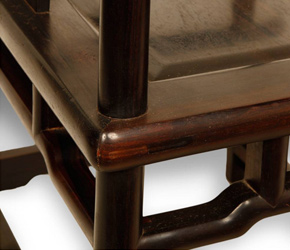 |
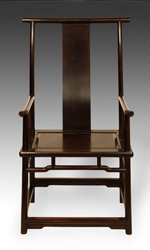 |
|
PRIMITIVE ID# F0304-264 |
||
Finally, in the Qing dynasty designs became bolder, more elaborate and complex. New political developments also lifted a ban on trade, allowing for the import of rare hardwoods which had previously been difficult to obtain within China. These denser woods allowed artisans to craft even finer works of art that were slender, more elegant and timeless in their beauty. Owing to their simple yet graceful designs Chinese yoke-back chairs can be seamlessly incorporated into modern interiors, making them a favorite among the professional design community. The design and popularity of the yoke-back chair has withstood the test of time. This style has become a seat not only for officials, but for anyone who is drawn to its unique artistic design. Had I known about yoke back chairs in my childhood I may have added one as a tenth chair in my room. After all, I did have hats to hang!
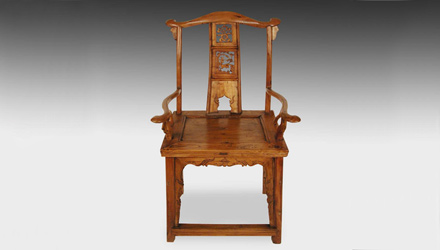 |
Download this Article: A Chair To Hang Your Hat On.pdf